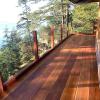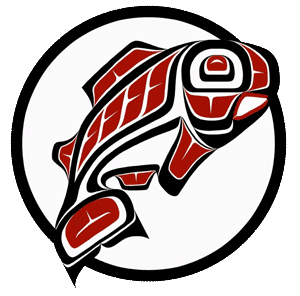Main Content
Our forests are defined by the presence of iconic coniferous tree species, including the western red cedar, Douglas fir, western hemlock, and Sitka spruce. These cornerstone species not only contribute to the region's lush and rugged landscape but have also served in essential ecological, cultural, and economic roles over time as each tree species is distinguished by its own unique characteristics - whether it’s the towering height and strength of the Douglas fir, the rot-resistant qualities of the western red cedar, the shade tolerance of the western hemlock, or the resilience of the Sitka spruce to severe coastal conditions. Ecologically, these trees support an array of plant and animal species, forming complex habitats that are crucial to the health of forest ecosystems. Culturally, they have deep-rooted significance for Indigenous Peoples who have long relied on them for building materials, unique tools and clothing, medicine, and spiritual practices. This subject is covered in considerable detail in the subsequent section of this display narrative. These tree species also provided vital resources for timber production, construction, and other related industries that supported livelihoods and contributed to the regional economy both in the State of Washington’s past and will most likely continue to do so in the future. Together, these trees shape the natural and human landscapes of the Pacific Northwest and provide a foundation for biodiversity and also serve as a testament to the deep interconnection between nature and human society.
Western Red Cedar
The western red cedar (Thuja plicata) is an iconic conifer native to the Pacific Northwest and is renowned for its towering presence, enduring beauty, durability and other distinctive physical properties. Capable of reaching remarkable heights between 100 and 200 feet and developing trunks that can exceed 9 feet in diameter, this majestic tree has captured the admiration of botanists, conservationists, and nature lovers alike. One of the largest and most celebrated specimens can be found near Kalaloch, Washington and is dubbed the Duncan Cedar or the Douglas Tree. It stands as a testament to the cedar’s longevity and resilience, with an estimated age of numerous centuries.
Characterized by its distinctive, scale-like leaves arranged in flat, feather-like sprays, the western red cedar emits a pleasant pineapple-like scent. This scent is especially noticeable when its leaves are crushed. This fragrance, combined with its reddish-brown bark that peels in long, fibrous strips, adds to its unique appeal. The tree is adorned with clusters of small, egg-shaped cones, which typically mature in early autumn, contributing to its unmistakable appearance
Apart from its impressive stature and beauty, the western red cedar holds additional cultural and ecological significance. It has been used for millennia by Indigenous peoples for various purposes, including the construction of canoes, totem poles, and longhouses. Its wood, known for its natural resistance to decay and pests, remains highly valued today in building and crafting. As a keystone species in its native ecosystem, the western red cedar supports diverse wildlife, providing shelter and nourishment for many birds, mammals, and insects.
While the species is somewhat protected today, it is still highly desired for many of its unique characteristics. It is naturally durable and resistant to rot, decay and insect infestation. Red cedar is also known for its dimensional stability. It not only has a low wood density; it also has a low shrinkage factor and swells and shrinks minimally with moisture content and/or humidity. In addition, this wood is highly water repellent. Other desirable properties are its insulating value and its ability to dampen sound transmission. These unique properties place it as one of the most highly valued tree species of the PNW forests.




Douglas Fir
The Douglas fir (Pseudotsuga menziesii) is one of North America's most towering and resilient trees and is fairly abundant across the landscapes of the Pacific Northwest. Coastal varieties of Douglas fir can soar up to an impressive 300 feet, with some of the oldest specimens reaching ages of over 500 years. This conifer’s formidable strength, adaptability to diverse environments, and natural resistance to decay have made it one of the continent’s most prized and economically significant timber sources for some time. The tree is distinguished by its deeply furrowed, thick bark, which is gray to brown in color and offers substantial protection against environmental stressors. Its needle-like leaves are arranged in spirals around the branches and release a citrusy, resinous scent when crushed. Additionally, the Douglas fir produces small cones with distinctive three-pointed bracts, resembling mouse tails, making it easy to identify among other evergreen species.
The Douglas fir’s wood is celebrated for its durability, high strength-to-weight ratio, and versatility, which have made it essential in both traditional and modern construction practices. For over a century, it has remained an invaluable material in carpentry from structural beams and flooring to fine joinery and furniture. Recently, it has been found to be an ideal starting material for new innovative sustainable building practices (such as in this building), referred to as cross-laminated timber (CLT). This eco-friendly engineered wood is transforming sustainable building practices. Douglas fir is a fairly light-colored wood that has a coarse to medium texture. It is highly valued for its density, hardness, strength, and stiffness which lead to its wide-scale use in building construction. It is also easy to work with, resist splitting and it holds screws and nails very well so that it is also popular for decking, flooring, and furniture manufacturing.
The economic impact of the Douglas fir is profound and is playing a key role in both regional forestry industries and national economies by providing jobs, supporting export markets, and contributing to sustainable resource management. Beyond its commercial value, the Douglas fir is an integral part of forest ecosystems, offering habitat and food sources for a variety of species. Its towering presence in mixed and old-growth forests serves as a symbol of strength, resilience, and natural heritage across North America.
Western Hemlock
The western hemlock (Tsuga heterophylla) stands as the tallest of the hemlock species, with mature trees reaching heights of up to 230 feet. Flourishing in the moist, temperate rainforests of the Pacific Northwest, particularly at lower coastal elevations, this towering evergreen is a defining feature of these lush ecosystems. Its dense wood and tannin-rich bark have long made it a valuable resource for Indigenous peoples, early settlers, and continues to be used for numerous applications today.
Easily recognizable by its graceful, drooping top and feathery branches, the western hemlock’s foliage has a unique appearance, with soft, flat needles of varying lengths that give its branches a delicate, layered texture. The tree’s bark is dark brown to reddish-brown and deeply furrowed which adds to its distinctive character. This hemlock also produces small, egg-shaped cones that dangle from its branches. These cones mature in the fall and are an essential food source for various bird species.
The western hemlock’s adaptable, workable wood has been prized for its strength and versatility, making it a staple in everything from cabinetry to framing lumber. It is commonly used as sheathing, siding, joists, rafters, flooring and planking. Also, due to its distinctive properties, hemlock is an outstanding wood choice for molding and other interior woodworking applications. It is also often used for window frames, wooden ceilings, and other utility purposes such as ladders and hand tools.
Beyond its material uses, the tree plays a vital ecological role in Pacific Northwest forests. It provides dense canopy cover that moderates temperatures and moisture levels, creating ideal conditions for shade-tolerant plants like ferns, mosses, and understory shrubs. Its presence fosters rich, biodiverse habitats, supporting a range of species, including mammals, birds, and invertebrates, all of which contribute to the complex web of life in these ancient rainforests.
As both a cultural and ecological asset, the western hemlock embodies the resilience and interconnectedness of the Pacific Northwest’s forests, continuing to shape both human lives and natural landscapes in profound ways.




Sitka Spruce
The Sitka spruce (Picea sitchensis) is a towering and iconic tree of the Pacific coastal forests, known for its remarkable height and versatile wood. Growing up to 300 feet tall with diameters reaching 15 feet, the Sitka spruce is one of the tallest conifer species in North America. Its lightweight yet strong wood has made it invaluable across numerous industries, embodying the ingenuity and resourcefulness of the communities that have utilized it for centuries.
This tree is easily recognizable by its straight trunk, dense branches, and distinctive bark, which starts smooth and gray but becomes scaly with age. Its sharp, needle-like leaves are bluish-green on top and lighter underneath, giving the branches a shimmering effect in sunlight. The Sitka spruce produces small, cylindrical cones that hang from its branches, maturing in the fall and releasing seeds vital for local wildlife.
Sitka spruce wood is highly valued for its unique combination of lightness, flexibility, and strength. These qualities make it an ideal material for manufacturing musical instruments, especially guitars, pianos, and violins, as it produces excellent acoustic resonance. Historically, Sitka spruce was also prized for its resilience in shipbuilding, used to create masts, hulls, and other parts requiring durable yet manageable material. It has also been used in the construction of aircraft, gliders, and oars. It’s high strength to weight ratio makes it ideal for applications where speed is important. Sitka spruce is also used to make wood pulp for a variety of paper products. Today, it continues to be used in various construction applications, from lightweight framing to specialty wood products.
Beyond its industrial significance, the Sitka spruce plays a crucial ecological role in coastal ecosystems, often found in moist, fog-laden forests along the Pacific coast. Its dense canopy moderates forest temperatures and retains moisture, creating a cool, damp environment that supports lush understory vegetation and diverse animal life. The Sitka spruce not only supports the habitat of countless plant and animal species but also plays a role in soil stabilization and carbon sequestration, contributing to the health and sustainability of coastal ecosystems.
The Sitka spruce stands as a symbol of adaptability and durability, a tree whose many uses and ecological functions reflect the deep knowledge and ingenuity of Pacific Northwest communities past and present.
Conclusion
These tree species not only served as essential resources for European settlers, fueling industries like shipbuilding, construction, and crafts, but they also embody a profound legacy of environmental knowledge and stewardship practiced by Indigenous communities for millennia. Indigenous peoples of the Pacific Northwest, such as the Coast Salish, Haida, and Tlingit, developed a nuanced understanding of these trees and their ecosystems, using them not only for shelter, tools, and clothing but also for medicinal and ceremonial purposes. Their sustainable practices - like selective harvesting, seasonal gathering, and controlled burns - helped maintain the health and resilience of these forests, ensuring that they would continue to thrive for future generations.
Today, the ongoing significance of trees like the western red cedar, Douglas fir, western hemlock, and Sitka spruce highlights the intricate relationship between people and nature in the Pacific Northwest. These trees are woven into the cultural fabric of the region, with their presence inspiring art, mythology, and spiritual practices that reflect a deep reverence for the land. Additionally, as climate challenges intensify, these species underscore the importance of sustainable forestry and conservation efforts, standing as living reminders of the region’s unique ecological and cultural heritage.
In essence, these towering giants are more than just natural resources; they are symbols of the Pacific Northwest’s values, heritage, and identity. Their continued protection and reverence are vital to preserving the region’s legacy, ensuring that future generations can connect with the land and its history. By honoring these trees and the wisdom of those who have long depended on them, we not only safeguard a unique natural landscape but also uphold the principles of respect, sustainability, and harmony that define the Pacific Northwest.
